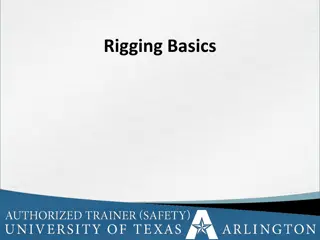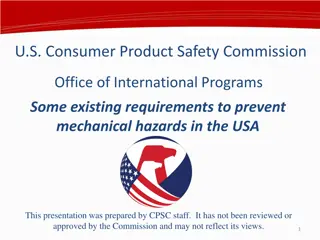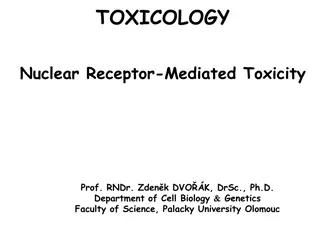Oil and Gas Industry Hazards and Control Measures
Learn to mitigate fire, explosion, exposure, physical hazards, falls, transportation risks, and natural hazards in the oil and gas sector. Effective control measures reduce risks and ensure worker safety. Explore key safety protocols.
2 views • 13 slides
Ensuring Mine Road Safety: Key Controls and Hazards
National Mine Safety Week 2023 focuses on safe road conditions in mining areas. The environment poses risks like overhanging trees and weather conditions, while road-related hazards include heavy loads and road design issues. This article highlights driving hazards, road design and maintenance hazar
1 views • 9 slides
Workplace Hazards and Safety Measures Awareness
Learn about common workplace hazards such as falls, chemical exposure, fire, electrical hazards, and repetitive motion injuries. Understand the risks associated with these hazards and the importance of prioritizing safety in the workplace to prevent accidents and injuries. Stay informed and take pro
1 views • 33 slides
Biological Hazards in the Hospital Community
Healthcare workers face various occupational hazards, including biological risks, in hospital settings. This article by Ephraim E. Ibadin explores the definition, types, risk factors, sources, prevention, and control of biological hazards in hospitals, emphasizing the importance of protecting worker
0 views • 30 slides
Environmental Hazards Faced by Veterans and Agent Orange Exposure Locations
Veterans may have been exposed to a variety of environmental hazards during their military service, including Agent Orange-related diseases, Gulf War illnesses, radiation-related diseases, traumatic brain injury, and more. Agent Orange exposure locations include Vietnam, C-123 airplanes, Blue Water
1 views • 40 slides
Understanding Pharmaceutical Degradation: Types and Factors
Pharmaceutical degradation refers to the process of a formulation in a specific container losing its chemical, microbiological, therapeutic, physical, and toxicological specifications. It can be categorized into physical, chemical, and microbiological degradation. Physical degradation alters the dru
1 views • 50 slides
Essential Crane Safety Training and Hazards Awareness
This training covers various hazards associated with crane use, OSHA standards, inspection guidelines, and common issues like electrical hazards, overloading, and poor weight distribution. The content emphasizes the importance of maintaining crane safety to prevent accidents, injuries, and damage to
0 views • 30 slides
Understanding Postmortem Redistribution in Forensic Toxicology
Postmortem Redistribution (PMR) refers to the variation in drug concentrations obtained from postmortem samples, which may not accurately reflect the levels at the time of death due to redistribution mechanisms. In forensic toxicology, assessing drug severity relies on blood concentrations, with cha
0 views • 16 slides
Rigging Safety and Hazards Awareness
Learn about common rigging hazards, including fall hazards, struck-by and crushing hazards, electrical hazards, and rigging failure examples. Understand the importance of proper training, equipment inspection, and safety protocols to prevent accidents and injuries in rigging operations.
0 views • 34 slides
Preventing Mechanical Hazards in Consumer Products: U.S. Regulations
The U.S. Consumer Product Safety Commission (CPSC) enforces various requirements to prevent mechanical hazards in consumer products. These regulations cover toys, children's clothing, infant products, and more. Standards such as ASTM F963 outline specific safety measures for small parts, strangulati
1 views • 13 slides
Importance of Workplace Inspections and Hazard Identification
Workplace inspections are critical processes to identify and mitigate hazards in a work environment. These inspections help ensure the safety of employees by addressing potential risks such as biological, chemical, physical, safety, ergonomic, and psychosocial hazards. Regular inspections allow for
2 views • 12 slides
Understanding Major Accident Hazards and Bowtie Models
Gain insight into the barriers protecting against hazards and explore the bowtie model's impact on safety. Learn about layers of protection, threats, preventative and mitigative barriers using the example of a caged lion scenario. Discover how to build a bowtie diagram to identify hazards effectivel
0 views • 11 slides
Understanding Natural Hazards and Their Impacts
Natural hazards, including tectonic and weather-related events, pose significant risks to humans and property. The effects and responses to tectonic hazards vary based on wealth levels in different regions. Earthquakes and volcanic eruptions result from physical processes, with patterns observed alo
1 views • 15 slides
Understanding Natural Hazards and Their Impact on Society
Explore the world of natural hazards, their causes, examples, and the transition to natural disasters. Learn how human actions can influence the frequency and severity of hazards. Discover the interconnectedness between nature and society in dealing with these events.
0 views • 10 slides
Understanding Risk Assessments and Hazards in Everyday Life
Risk assessments involve evaluating potential hazards and assessing the likelihood and consequences of those hazards. In the context of crossing the road, different scenarios demonstrate varying levels of risk based on factors such as vehicle speed, pedestrian behavior, and road conditions. By under
0 views • 23 slides
Ensuring Office Safety: Hazards, Prevention, and Training
Today's offices are prone to various hazards that can lead to injuries and health issues. This presentation covers common office accidents, safety considerations, and preventive measures such as ergonomic practices, fall prevention, and emergency action plans. It emphasizes the importance of control
0 views • 44 slides
Occupational Hazards in Healthcare and Engineering Equipment Development for COVID-19 Protection
Corona Virus, or COVID-19, poses significant health hazards to individuals, especially healthcare workers. This article explores the spread of the virus, types of health hazards, and solutions for prevention. It emphasizes the critical need for developing engineering equipment to support and protect
0 views • 12 slides
Understanding Environmental Hazards and Management
Exploring major hazards management, geology perspectives, ecological concepts, natural environmental hazards, classes of natural hazards, and introduction to environmental hazards management. The content covers ecological levels, abiotic factors, biomes, environmental degradation, and more.
0 views • 10 slides
Understanding Workplace Safety Hazards: Physical, Chemical, and Biological Risks
Explore the three main types of workplace safety hazards - physical, chemical, and biological - with a focus on identifying potential risks and ensuring a safe work environment. Learn about common hazards such as repetitive motion, chemical exposure, and handling biological materials, essential for
0 views • 97 slides
Understanding Natural Hazards and Plate Boundaries
Learn about natural hazards such as volcanic eruptions, earthquakes, and storms that pose risks to human populations. Discover how factors like urbanization, poverty, climate change, and farming increase vulnerabilities to these hazards. Explore plate boundaries, crust types, and examples of geologi
0 views • 21 slides
Understanding Immunotoxicity in Fish: An Alternative Model for Toxicological Studies
The study explores the immunotoxic effects of industrial effluents on fin fish, highlighting xenobiotics' impact on the immune system. It discusses the sensitivity of the immune system to environmental toxins and the elicitation of immune reactions by various substances. The importance of fish as a
0 views • 25 slides
Understanding Antiemetic Screening Models in Pharmaceutical Science
Explore the fascinating world of antiemetic screening models in pharmaceutical science, covering topics such as the pathogenesis of vomiting, choice of emetogens, commonly used animals, parameters assessed, screening models, and more. Learn about drug-induced emesis models and the critical parameter
0 views • 25 slides
Preventing Slips, Trips, and Falls: Hazard Awareness and Safety Guidelines
Be aware of hazards both indoors and outdoors to prevent slips, trips, and falls. Keep work areas clear, return equipment to designated places, and report hazards to managers promptly. Look ahead for hazards, avoid distractions while walking, and conduct dynamic risk assessments to ensure safety. Re
0 views • 4 slides
Understanding Environmental Health and Hazards
The field of environmental health focuses on preventing human injury and illness by evaluating and limiting exposure to hazardous agents in the air, water, and soil. Various environmental hazards such as water and air pollution, climate change, and occupational hazards pose significant risks to huma
0 views • 10 slides
Understanding Volcanic Hazards: Tephra, Ash Clouds, and Lava Flows
Explosive volcanic eruptions produce tephra, fragments of rock that can be carried by volcanic plumes, ash clouds, and lava flows. Tephra, including blocks, bombs, and lapilli, poses aviation hazards, infrastructure disruptions, and health risks. Ashfall can impact communities and agriculture over v
0 views • 4 slides
Understanding Volcanic Hazards: Session Overview by Dr. Patrick Asamoah Sakyi
This session by Dr. Patrick Asamoah Sakyi introduces students to the hazards associated with volcanoes, covering topics such as volcanic eruption components, primary and secondary effects of volcanic hazards, beneficial aspects of volcanism, and predicting volcanic eruptions. The session also includ
0 views • 35 slides
Understanding Processor Hazards and Pipeline Stalls
Explore processor hazards like load-use and data hazards, along with strategies to avoid stalls in the pipeline. Discover how to detect and handle hazards efficiently for optimal performance in computer architecture. Learn about forwarding conditions, datapath design, and the impact of hazards on in
0 views • 30 slides
Understanding the Hazards of Arc Flash Incidents by Littelfuse Startco
Littelfuse Startco highlights the dangers of arc flash incidents, emphasizing the costly and dangerous consequences such as fires, burns, injuries, and even fatalities. The case study of an electrician's severe burns serves as a stark reminder of the potential risks associated with electrical hazard
0 views • 24 slides
Combining Natural Hazards with Societal Issues: Unit 1 Hazard Map Template
Delve into Unit 1 of the Hazard Map Template, identifying and locating regions susceptible to hazards by choosing top hazards in the mapping area. Create hazard maps, combine shapes, and include a key and sources for a comprehensive view of potential hazards and vulnerabilities.
0 views • 13 slides
Understanding Pipeline Hazards in Computer Architecture
Pipeline hazards in computer architecture are classified into three categories: structural, data, and control hazards. Structural hazards occur due to conflicts in hardware resources, data hazards stem from dependencies between instructions, and control hazards arise from branching instructions. The
0 views • 42 slides
Clinical Cases Review: Neurological, Toxicological, and Orthopedic Presentations
Explore a collection of intriguing clinical cases including neurological symptoms, toxic ingestion, loss of consciousness, and orthopedic injuries. From CT findings to treatment modalities, delve into differential diagnoses, imaging investigations, risk factors, complications, and management strateg
0 views • 13 slides
Workshop on Artificial Intelligence in Natural Hazards Engineering
This workshop focuses on exploring the integration of artificial intelligence and machine learning with natural hazards engineering, discussing data representations, classification models, combining ML with hazards simulations, and addressing classification problems in the field. Participants engage
0 views • 5 slides
Map Your Hazards Module Overview: Identifying Natural Hazards and Social Vulnerabilities
Explore the Map Your Hazards Module, a comprehensive program designed to help communities identify natural hazards, assess social vulnerabilities, and enhance preparedness. Through tasks like local risk mapping and social surveys, learn to mitigate risks and support communities in facing potential d
0 views • 17 slides
Recognizing Laboratory Hazards: Physical Hazards and Corrosive Chemicals
Laboratory hazards, particularly physical hazards and corrosive chemicals, pose risks to individuals working in laboratory settings. Corrosives, such as acids, bases, oxidizing agents, and gases, can cause significant harm to eyes and skin. Proper precautions and handling procedures are crucial to m
0 views • 16 slides
Nuclear Receptor-Mediated Toxicity: Molecular Insights and Implications
TOXICOLOGY research on Nuclear Receptor-Mediated Toxicity by Prof. Zdeněk Dvořák delves into the evidence, molecular properties, structures, and signaling pathways of nuclear receptors such as Aryl Hydrocarbon Receptor (AhR). Detailed information on the impact of AhR-mediated toxicity, including
0 views • 19 slides
Understanding Skin Sensitisation through Adverse Outcome Pathways (AOP)
The Adverse Outcome Pathway (AOP) for Skin Sensitisation provides a mechanistic framework linking Molecular Initiating Events (MIE) to Adverse Outcomes (AO) through Key Events (KE) and Key Event Relationships (KER). AOPs offer a transparent justification for toxicological predictions and play a vita
0 views • 21 slides
Data Hazards in Pipelined Processors: Understanding and Mitigation
Explore the concept of data hazards in pipelined processors, focusing on read-after-write (RAW) hazards and their impact on pipeline performance. Learn strategies to mitigate data hazards, such as using a scoreboard to track instructions and stall the Fetch stage when necessary. Discover how adjusti
0 views • 23 slides
Understanding Biological Hazards in the Workplace: A Comprehensive Overview
This chapter delves into the realm of biological hazards in occupational settings, shedding light on the risks posed by microorganisms, arthropods, allergens, toxins, and more. It highlights the diverse range of biological agents that can lead to infections, allergies, toxic reactions, and even seri
0 views • 45 slides
Toxicological Review of Ethyl Tertiary Butyl Ether (ETBE) by Japan Petroleum Energy Center (JPEC)
The Japan Petroleum Energy Center (JPEC) conducted extensive studies on Ethyl Tertiary Butyl Ether (ETBE) to assess its toxicity, carcinogenicity, and health risks. The research concluded that the use of 7% ETBE-blended gasoline in Japan does not pose significant human health risks through oral or i
0 views • 7 slides
Understanding Inhalant Abuse: Risks, Effects, and Prevention
Inhalant abuse is a widespread issue, with volatile substances being inhaled to achieve psychoactive effects. This form of substance abuse poses significant toxicological and social hazards, often affecting marginalized populations such as neglected street children. The accessibility, affordability,
0 views • 44 slides







































